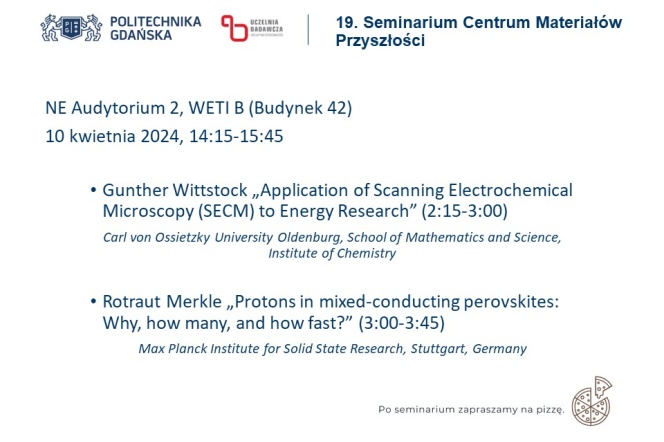Data dodania: 2024-03-27
19. Seminarium Centrum Materiałów Przyszłości

Dziewiętnaste seminarium Centrum Materiałów Przyszłości odbędzie się 10 kwietnia 2024 r. o godz. 14.15 w NE Aud. 2 WETI B (budynek 42).
Prof. Gunther Wittstock z Carl von Ossietzky University Oldenburg, School of Mathematics and Science, Institute of Chemistry (Oldenburg, Niemcy) wygłosi wykład pt. "Application of Scanning Electrochemical Microscopy (SECM) to Energy Research" (14:15-15:00).
Prof. Rotraut Merkle z Max Planck Institute for Solid State Research (Stuttgart, Niemcy) wygłosi wykład pt. "Protons in mixed-conducting perovskites: Why, how many, and how fast?" (15:00-15:45).
Po seminarium zapraszamy na pizzę.
Abstrakty wystąpień:
- "Application of Scanning Electrochemical Microscopy (SECM) to Energy Research"
Scanning electrochemical microscopy (SECM) is a method that provides images of electrochemical reactivity and can be used as a tool for kinetic analyses. Interfaces in electrochemical energy conversion devices are typically made from composite electrodes that show laterally varying reactivity which can greatly impact their performance. SECM offers several approaches to access information on heterogeneously distributed reactivities.
Examples are taken from negative electrodes of lithium and lithium-ion batteries and oxygen reduction gas-diffusion electrodes.
- "Protons in mixed-conducting perovskites: Why, how many, and how fast?"
"Defects" are the key ingredients that allow for ion transport in solids, and thus enable the functioning of devices such as fuel and electrolyzer cells based on ceramic ion conductors as electrolyte, which operate at intermediate to high temperature. A specific advantage of proton conducting ceramic cells is that in electrolysis mode compressed and (almost) dry hydrogen is obtained directly.
This talk is focused on the defect chemistry and transport properties of "triple conducting" perovskite oxides which exhibit electronic conductivity from holes and ionic conductivity from oxygen vacancies and protons. They are important as electrode materials for protonic ceramic fuel/electrolyzer cells, or for hydrogen permeation membranes.
The proton uptake can occur through hydration (acid-base reaction) or hydrogenation (redox reaction), depending on the actual material and conditions.[1,2] Triple conducting perovskites based on BaFeO3 typically show lower degrees of hydration than proton conducting Ba(Ce,Zr,Y)O3-z electrolytes. The reasons are elucidated with a combination of experiments and DFT calculations - the high covalency of the Fe-O bonds decreases the basicity of the oxide ions. Oversized dopants such as Zn2+,Y3+ induce local lattice distortions and in turn increase the proton uptake.[3,4]
Owing to the predominant electronic conductivity, measurements of proton conductivity and mobility in BaFeO3-d are very challenging. Therefore, we performed an extended DFT investigation.[5] The proton transfer begins with an approach of donating and receiving oxygen, followed by the actual breaking of the O-H bond. The calculated proton migration barrier is significantly lower than the barrier for oxide ion migration, and amounts to approx. 0.2 eV. Overall, a comprehensive picture of proton stability and mobility and of its determining factors is obtained, which can be employed in further materials optimization.

